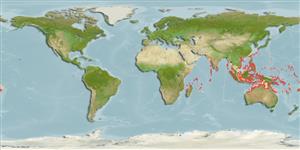>
Eupercaria/misc (Various families in series Eupercaria) >
Lethrinidae (Emperors or scavengers) > Lethrininae
Etymology: Lethrinus: Greek, lethrinia, a fish pertaining to genus Pagellus.
More on author: Valenciennes.
Environment: milieu / climate zone / depth range / distribution range
Ecología
marino asociado a arrecife; no migratorio; rango de profundidad 4 - 35 m (Ref. 90102). Tropical; 30°N - 21°S
Indo-West Pacific: Sri Lanka to the Marshall and Solomon islands, north to the Ryukyu Islands, south to northern Australia.
Tamaño / Peso / Age
Maturity: Lm ? range ? - ? cm
Max length : 35.0 cm TL macho / no sexado; (Ref. 2295); common length : 29.0 cm SL macho / no sexado; (Ref. 37816)
Espinas dorsales (total): 10; Radios blandos dorsales (total): 9; Espinas anales 3; Radios blandos anales: 8. Body is brown or tan, with scattered irregular small black blotches, a large oblong black blotch below soft-rayed portion of dorsal fin and bordering below the lateral line. The fins are pale or pinkish.
Solitary or in groups (Ref. 90102). Inhabits shallow seagrass beds, reef flats, lagoons, and sandy areas near coral reefs. Feeds on benthic invertebrates and small fish. Also caught with beach seines and handlines and is marketed fresh (Ref. 9775).
Life cycle and mating behavior
Madurez | Reproducción | Puesta | Huevos | Fecundidad | Larva
Carpenter, K.E. and G.R. Allen, 1989. FAO Species Catalogue. Vol. 9. Emperor fishes and large-eye breams of the world (family Lethrinidae). An annotated and illustrated catalogue of lethrinid species known to date. FAO Fish. Synop. 125(9):118 p. Rome: FAO. (Ref. 2295)
IUCN Red List Status (Ref. 130435)
Threat to humans
Harmless
Human uses
Pesquerías: escaso valor comercial
Más información
Nombres comunesSinónimosMetabolismoDespredadoresEcotoxicologíaReproducciónMadurezPuestaAgregación para la puestaFecundidadHuevosEgg development
ReferenciasAcuiculturaPerfil de acuiculturaRazasGenéticaElectrophoresesheritabilidadEnfermedadesProcesamientoNutrientsMass conversion
Herramientas
Special reports
Download XML
Fuentes de Internet
Estimates based on models
Preferred temperature (Ref.
123201): 26.2 - 28.9, mean 27.9 °C (based on 396 cells).
Phylogenetic diversity index (Ref.
82804): PD
50 = 0.5000 [Uniqueness, from 0.5 = low to 2.0 = high].
Bayesian length-weight: a=0.01318 (0.00806 - 0.02156), b=3.00 (2.87 - 3.13), in cm total length, based on LWR estimates for this species & Genus-body shape (Ref.
93245).
Nivel trófico (Ref.
69278): 4.0 ±0.64 se; based on food items.
Generation time: 1.9 ( na - na) years. Estimated as median ln(3)/K based on 2
growth studies.
Resiliencia (Ref.
120179): Alto, población duplicada en un tiempo mínimo inferior a 15 meses (K=0.5-0.7).
Fishing Vulnerability (Ref.
59153): Low vulnerability (25 of 100).
Nutrients (Ref.
124155): Calcium = 58.4 [39.8, 93.9] mg/100g; Iron = 0.962 [0.622, 1.426] mg/100g; Protein = 20.4 [17.8, 22.6] %; Omega3 = 0.139 [0.096, 0.203] g/100g; Selenium = 36.7 [22.7, 62.9] μg/100g; VitaminA = 31.3 [6.7, 176.2] μg/100g; Zinc = 2.14 [1.59, 2.81] mg/100g (wet weight);
